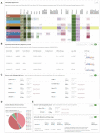VannoPortal: multiscale functional annotation of human genetic variants for interrogating molecular mechanism of traits and diseases
- PMID: 34570217
- PMCID: PMC8728305
- DOI: 10.1093/nar/gkab853
VannoPortal: multiscale functional annotation of human genetic variants for interrogating molecular mechanism of traits and diseases
Abstract
Interpreting the molecular mechanism of genomic variations and their causal relationship with diseases/traits are important and challenging problems in the human genetic study. To provide comprehensive and context-specific variant annotations for biologists and clinicians, here, by systematically integrating over 4TB genomic/epigenomic profiles and frequently-used annotation databases from various biological domains, we develop a variant annotation database, called VannoPortal. In general, the database has following major features: (i) systematically integrates 40 genome-wide variant annotations and prediction scores regarding allele frequency, linkage disequilibrium, evolutionary signature, disease/trait association, tissue/cell type-specific epigenome, base-wise functional prediction, allelic imbalance and pathogenicity; (ii) equips with our recent novel index system and parallel random-sweep searching algorithms for efficient management of backend databases and information extraction; (iii) greatly expands context-dependent variant annotation to incorporate large-scale epigenomic maps and regulatory profiles (such as EpiMap) across over 33 tissue/cell types; (iv) compiles many genome-scale base-wise prediction scores for regulatory/pathogenic variant classification beyond protein-coding region; (v) enables fast retrieval and direct comparison of functional evidence among linked variants using highly interactive web panel in addition to plain table; (vi) introduces many visualization functions for more efficient identification and interpretation of functional variants in single web page. VannoPortal is freely available at http://mulinlab.org/vportal.
© The Author(s) 2021. Published by Oxford University Press on behalf of Nucleic Acids Research.
Figures



References
-
- Stunnenberg H.G., International Human Epigenome C., Hirst M.. The international human epigenome consortium: a blueprint for scientific collaboration and discovery. Cell. 2016; 167:1145–1149. - PubMed
Publication types
MeSH terms
LinkOut - more resources
Full Text Sources
Medical

